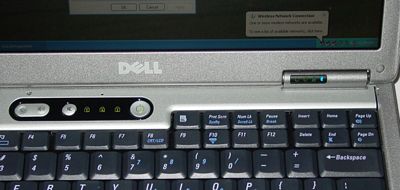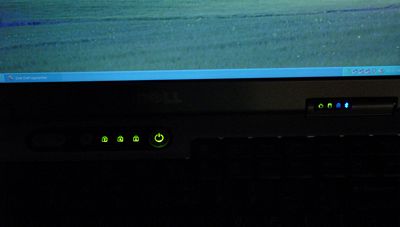Mid-sized Dothan Notebook Roundup: Dell, Gateway, and HP/Compaq
by Andrew Ku on September 30, 2004 1:09 AM EST- Posted in
- Laptops
Dell Latitude D600: In the Field (cont.)
DisplayThe unit's 14.1" SXGA+ display is what we have come to expect; reasonably bright with crisp text at its native resolution, 1400 x 1050. With notebook pricing falling, we highly recommend going after a SXGA+ display, if you want a notebook with a 14.1" or 15.0" display. For us, at least, it just feels more natural than a XGA display, which is better suited for true ultraportables like Asus' S5200N.
In terms of brightness across the scheme of other notebooks, Dell's D600 (8 settings) seems to be brighter of the three on battery power. Though, HP (10 settings) seems brighter than the D600 on AC power. However, Gateway (8 settings) beats all three out when it comes to getting the display at its dimmest setting.
LEDS
The LEDs are well placed and implemented in the D600. There are four LEDS visible when the display is closed (left to right: power - green when active, hard drive - green when active, battery status - green when charging, and wireless/Bluetooth - blue when active).
There is another set of LEDs visible that are centered directly above the keyboard (left to right: number lock - green when active, caps lock - green when active, and scroll lock - green when active). The power button is also illuminated when the system is on/active. The benefit of Dell's design is that you know exactly what each LED represents by its illuminated symbol.
Above the middle LED, which is above the keyboard, sits the system integrated microphone; it's marked by a small pinhole.
Charger
The charger hasn't changed from their previous iterations, as it is the same one used for the consumer and business line. While it is a small detail, the rubber strap helps keep the cable clutter at a minimum.













23 Comments
View All Comments
Monkeydonutstick - Thursday, September 30, 2004 - link
You can't be serious about comparing a Powerbook G4 to any of these. Powerbooks were owned by P3’s for Christ sake.plewis00 - Thursday, September 30, 2004 - link
I just wanted to point out as an nc6000 user that you didn't mention it's speakers (which as any Compaq user will know) are some of the best on any laptop - very rich with reasonable bass and strong volume, it easily rivals small stereos.Secondly, I don't think it's quite clear how much tougher the HP is than the Dell. I had both and pressing slightly on the Dell logo on the D600 would flex it down by about 3-4mm with very little pressure; the HP is far more robust, so it's size isn't that much of an issue (but the Dell is a bit of a headturner, the HP definitely isn't).
Also (only a small point) but given the Dell's and HP's graphics cards, a small 3D-based test (3DMark2001 SE?) wouldn't have gone amiss [that's the reason I had these machines for their size and graphics]. In seriousness, with that Gateway, what are you going to do with a 1.7Ghz Dothan CPU if not game sometimes, or that you couldn't do with a Pentium III-M 850Mhz?
manno - Thursday, September 30, 2004 - link
ksherman- "wheres the Macs? As far as im concerned, the Powerbook owns all these in terms of performance, size, weight, looks, and battery life... Its apparently even in the same price range as these "mid-sized" laptops... Bring on the Mac articles AT!"I have no clue about the technical aspect of the powerbooks size, weight, and battery life. But I do know you couldn't be more right about the looks... PLUS there's a Quake I... and I think a Quake II software renderer for Macs also... nudge nudge wink wink.
manno - Thursday, September 30, 2004 - link
SOFTWARE renderer origianl "Half-Life" or "Quake 2". Preferably Half-Life. Their software reneder is more taxing than Quake 2's. Old school, yes, but it's not biased tward desktop, or laptop video cards.peace on!... Crakers!
AndrewKu - Thursday, September 30, 2004 - link
#4 - Hopefully, we will get to that real soon.AndrewKu - Thursday, September 30, 2004 - link
#6 - Well, I hope we didn't knock it too much in the overall sense. But we are talking about the business user market segment, and we were putting more emphasis on the display more so than the other nic nacs.YaBaBom - Thursday, September 30, 2004 - link
I'm not a Gateway fan, but I think it's kind of silly to knock the Gateway laptop in the ratings because it doesn't have gigabit ethernet. Gigabit ethernet is nothing but a sales pitch as far as laptops are concerned, since the hard drives just arent capable of supplying data at gigabit speeds. I can tell you from experience that a D600 with gigabit doesnt transfer any faster than a C640 with 10/100 ethernet.brainwave64 - Thursday, September 30, 2004 - link
Great review! Very informative. It's hard to find good reviews of laptops that take into account things other than performance - like ergonomics, LED locations, battery life, weight, size, etc.--paperboy164
ksherman - Thursday, September 30, 2004 - link
wheres the Macs? As far as im concerned, the Powerbook owns all these in terms of performance, size, weight, looks, and battery life... Its apparently even in the same price range as these "mid-sized" laptops... Bring on the Mac articles AT!AndrewKu - Thursday, September 30, 2004 - link
#1 - A64 based laptops, at least so far, are those best reserved for the DTR market, and thus are focused on the performance aspect of the notebook market. If you want mobility, get a P-M based notebook.As for half-life or other gaming applications, one of these notebooks uses Intel's integrated graphic's system, so that wasn't something that was practical, and of the other two that use discrete GPUs, one uses a DX8 mobile graphics part.
#2 - Well... As far as weight and the general specs go, I think the whole market is becoming more and more grey. We will be back with a thin and light side of the Dothan market.